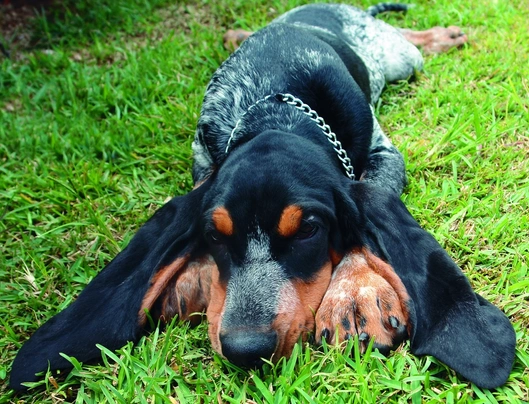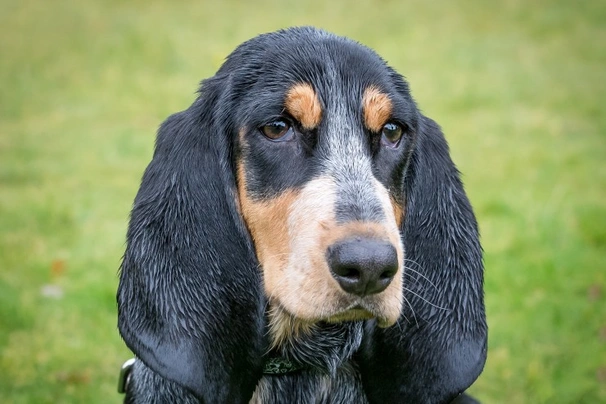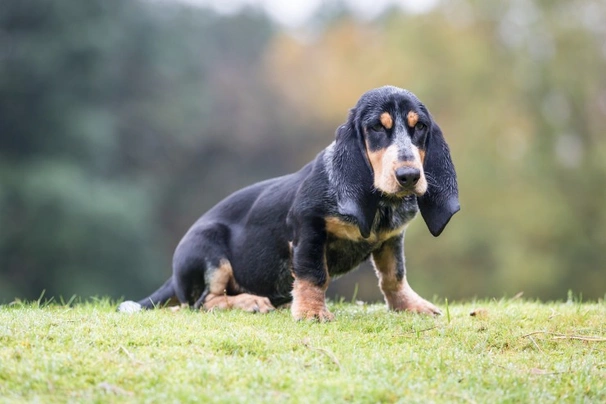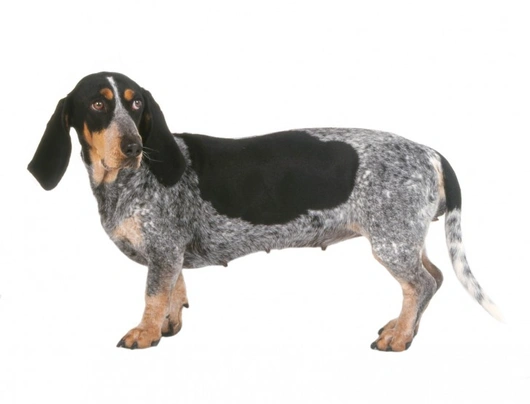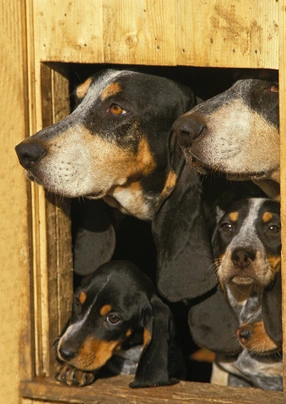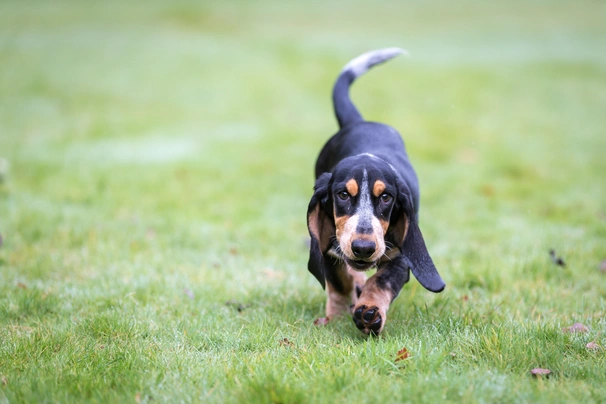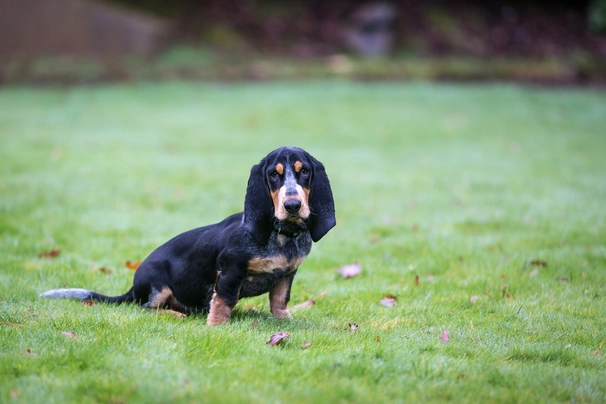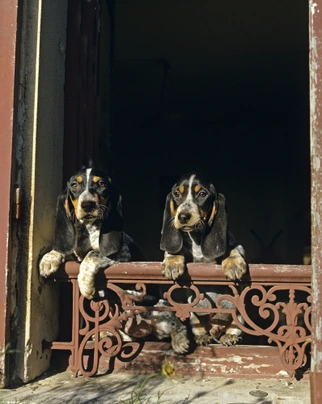Basset Bleu De Gascogne
Introduction of the Basset Bleu De Gascogne
The Basset Bleu de Gascogne is a hound native to France and the breed has only recently been introduced to the UK. As such these lovely hounds are among the lesser known French hounds here in Britain. They were first bred in the Gascony region of France hence their name. They are charming dogs and although originally bred to work they make wonderfully loyal and affectionate companions and family pets. The Basset Bleu de Gascogne was only recognised as a breed in their own right by The Kennel Club in the 1990's and although still very popular in France they are not so in demand over here. As such anyone wishing to share a home with a Basset Bleu would need to register their interest with a breeder and be put on a waiting list because so few pedigree puppies are bred every year.
History of the Basset Bleu De Gascogne
There are records of the Basset Bleu de Gascogne that date back as far back as the 14th century. They are the descendants of the Grand Bleu de Gascogne and although it's not known just how the breed first came about there are a lot of theories as their origins. This includes the breed having been developed through crossbreeding or that these hounds are a natural mutation of the Grand Bleu de Gascogne which could account for the fact their coat colouring is so similar. It is also thought the breed was then further developed after the French Revolution with an end goal being to create a dog capable of following the hounds and horses while at the same time being slow enough for people on foot out in the hunting field to keep pace with.
The Basset Bleu de Gascogne was recognised by The Kennel Club as a breed in the 1990's but these charming hounds remain relatively unknown here in the UK although they are renowned in their native France for not only being very able working dogs but wonderful companions and loyal family pets too. As such anyone wishing to share their home with a Basset Bleu de Gascogne would have to register their interest with a breeder and go on a waiting list because so few puppies are bred and registered every year.
Appearance of the Basset Bleu De Gascogne
Height at the withers: 34 - 38 Males cm Females 34 - 38 cm
Average weight: Males 15 - 18 kg Females 15 - 18 kg
The Basset Bleu de Gascogne is similar looking to the Basset Hound because they are short in the leg long in the body and boast having quite large heads with one difference being in their coat colouring. A Basset Bleu's head is wedge shaped and they are domed with dogs having a well-defined occipital point at the back of their heads. Their forefaces are long with a slight aquiline look about them and dogs boast large black noses with wide opened nostrils true to their scent hound heritage.
Eyes are a dark brown and oval shaped with the Basset Bleu having a gentle yet sad expression in them which adds to their overall endearing appearance. Ears are set low and fine to the touch curling inwards. They have a strong jaw with a perfect scissor bite where their upper teeth neatly overlap their lower ones. Necks are long and slightly arched with dogs having a slight dewlap around their throats. Their front legs are straight well boned although in some dogs they are a little crooked which is acceptable. Shoulders are well muscled without being heavy and nicely laid back.
Their bodies are long with dogs having deep chests that extend to their elbow showing a prominent sternum. Their ribs are well rounded and a dog's back is strong long and level. Loins are strong and short being slightly arched. Bellies can have a slight tuck up adding an athletic look to a Basset Bleu's body. Back legs are well muscled and powerful and a dog's feet are strong oval shaped with black nails and pads. Their tails are set high which dogs carry gaily in the shape of a sickle when alert or excited but down when relaxed. It is broadest at the base before tapering to the tip.
When it comes to their coat the Basset Bleu de Gascogne boasts having a short and dense coat that's not too fine. Accepted breed colours are as follows:
- Black on a white base coat covered entirely with black mottling and ticking which creates a blue appearance
Dogs have two black marks on their heads which cover both ears and which encompasses their eyes before ending at a dog's cheeks. They have a tan spot above each eye which gives the Basset Bleu the appearance of having "4" eyes. They also have tan marks on their cheeks inside their ears flews on their legs and under the tail.
Temperament of the Basset Bleu De Gascogne
The Basset Bleu de Gascogne is a laid back character in the home environment and would happily turn into a couch potato if they are allowed to. They are a great choice for people who lead more sedentary lives and who boast having a secure large back garden for their dogs to roam around in whenever they please. That said they need to be given the right amount of exercise and mental stimulation to be truly happy well-rounded dogs. They are also prone to putting on too much weight if they are not given enough exercise which can seriously impact their overall wellbeing and health.
They are loyal affectionate hounds that form strong bonds with their families. They are also known to be rather placid which is one of the reasons they make such nice family pets. The Basset Bleu has a real affinity with children and enjoys being around them. They are intelligent but like many other hound breeds they do boast having a bit of a stubborn streak in them which can make training a little challenging.
Socialising a puppy and young Basset Bleu de Gascogne from an early age is essential and it has to involve introducing them to as many new situations noises people other dogs and animals as possible so they mature to be confident outgoing mature dogs.
Intelligence / Trainability of the Basset Bleu De Gascogne
The Basset Bleu de Gascogne is an intelligent hound but they tend to be ruled by their noses and will happily take off if they pick up an interesting scent. As such their training has to start when puppies are still young and it has to be consistent throughout a dog's life so they understand what is expected of them. Particular attention has to be paid to the "recall" command and even then because their tracking instinct is so strong a Basset Bleu might choose to turn a deaf ear in order to follow a scent they've picked up.
Like many other hound breeds the Basset Bleu de Gascogne is a sensitive dog by nature and as such they do not answer well to any sort of harsh correction or heavy handed training methods which would more than likely just bring out the stubborn streak in them. They do respond very well to positive reinforcement training methods which always get the best out of these charming hounds. The thing to bear in mind is that these hounds tend to take life at their own pace which often means they can be a little slow when it comes to reacting to a command they are given.
Children and other
The Basset Bleu de Gascogne is highly prized in their native France for not only being extremely good hunting dogs but also for making great family pets because they seem to have a natural affinity with children. They love being in a family environment and around children of all ages. However they may be low to the ground but these hounds are powerful which means they may accidentally knock a toddler or young child over if playtime gets a little too boisterous. Whenever dogs and children are together it's best for any interaction to be supervised by an adult to make sure things stay nice and calm.
They generally get on well with other dogs more especially if a puppy has been well socialised from a young enough age. Care should be taken when they are around smaller animals and pets although if they have grown up with a family cat they usually get on well together. However A Basset Bleu would think nothing of chasing a neighbour’s cat.
Health of the Basset Bleu De Gascogne
The average life expectancy of a Basset Bleu de Gascogne is between 12 and 14 years when properly cared for and fed an appropriate good quality diet to suit their ages.
The Basset Blue is known to suffer from very few hereditary health issues and are known to be one of the more robust pure breeds. However they are prone to ear problems thanks to their length and shape which is why they need to be regularly checked. The two conditions that seem to affect the breed the most are as follows:
- Ear problems
- Bloat
Caring for the Basset Bleu De Gascogne
As with any other breed these hounds need to be groomed on a regular basis to make sure their coats and skin are kept in top condition. They also need to be given regular daily exercise to ensure they remain fit and healthy. On top of this dogs need to be fed good quality food that meets all their nutritional needs throughout their lives.
Grooming of the Basset Bleu De Gascogne
The Basset Bleu has a short dense coat and therefore they are low maintenance in the grooming department. A weekly brush and wipe over with a chamois leather is all it takes to keep their coat looking good. They shed throughout the year although more so during the Spring and then again in the Autumn when more frequent grooming is usually necessary to keep on top of things and any shed hair off the furniture.
It's also important to check a dog's ears on a regular basis and to clean them when necessary. If too much wax is allowed to build up in a dog's ears it can lead to a painful infection which can be hard to clear up. In short prevention is often easier than cure when it comes to ear infections. Because their ears are so long they tend to drag on the ground which can lead to dogs picking things up in them which would need to be removed sooner rather than later.
Exercise of the Basset Bleu De Gascogne
Although the Basset Bleu de Gascogne is a laid back hound they do need to be given the right amount of daily exercise and mental stimulation to keep them in good shape fit and healthy. They may be relaxed and placid around the house but once out on a walk these hounds are surprisingly agile. They need to be given a minimum of 40 to 60 minutes exercise a day and even more if possible and they also need to be given a lot of mental stimulation to prevent them from turning into real couch potatoes and putting on too much weight.
A shorter walk in the morning would be fine but a longer more interesting one in the afternoon is a must. These dogs also like to be able to roam around a back garden as often as possible so they can really let off steam. However the fencing has to be extremely secure to keep these scent hounds in because if they find a weakness in the fence they will soon escape out and get into all sorts of trouble.
With this said Basset Bleu puppies should not be over exercised because their joints and bones are still growing and too much pressure on them could result in causing a dog a few problems later on in their lives. They should not be allowed to jump up or off furniture nor should they be allowed to run up and down the stairs for this very reason. Because they have such long back preventing a dog from jumping up or running up and down stairs reduces the chances of them injuring their spines too.
Feeding of the Basset Bleu De Gascogne
If you get a Basset Bleu de Gascogne puppy from a breeder they would give you a feeding schedule and it's important to stick to the same routine feeding the same puppy food to avoid any tummy upsets. You can change a puppy's diet but this needs to be done very gradually always making sure they don't develop any digestive upsets and if they do it's best to put them back on their original diet and to discuss things with the vet before attempting to change it again.
Older dogs are not known to be fussy or finicky eaters but this does not mean you can feed them a lower quality diet. It's best to feed a mature dog twice a day once in the morning and then again in the evening making sure it's good quality food that meets all their nutritional requirements. It's also important that dogs be given the right amount of exercise so they burn off any excess calories or they might gain too much weight which can lead to all sorts of health issues. Obesity can shorten a dog's life by several years so it's important to keep an eye on their waistline from the word go.
Because the Basset Bleu de Gascogne is prone to suffer from bloat it is really important that they be fed twice a day instead of giving them just one larger meal a day. It's also a good idea to invest in a stand to place their feed bowl which makes it easier for these large dogs to eat comfortably without having to stretch their necks down low to reach their food. Dogs should never be exercised just before or just after they have eaten either because this puts them more a risk of suffering from bloat.
Basset Bleu De Gascogne price
If you are looking to buy a Basset Bleu De Gascogne you would need to register your interest with a breeder and agree to be put on a waiting list because only very few puppies are bred and registered with The Kennel Club every year. You should expect to pay anything upwards of £700 for a well-bred pedigree puppy. The cost of insuring a male 3-year-old Basset Bleu de Gascogne in northern England would be £26.89 a month for basic cover but for a lifetime policy this would set you back £61.72 a month (quote as of June 2016). When insurance companies calculate a pet's premium they factor in several things which includes where you live in the UK and a dog's age and whether or not they have been neutered or spayed.
When it comes to food costs you need to buy the best quality food whether wet or dry to feed your dog throughout their lives making sure it suits the different stages of their lives. This would set you back between £30 - £40 a month. On top of all of this you would need to factor in veterinary costs if you want to share your home with a Basset Bleu and this includes their initial vaccinations their annual boosters the cost of neutering or spaying your dog when the time is right and their yearly health checks all of which quickly adds up to over £1000 a year.
As a rough guide the average cost to keep and care for a Basset Bleu de Gascogne would be between £70 to £110 a month depending on the level of insurance cover you opt to buy for your dog but this does not include the initial cost of buying a pedigree puppy.

